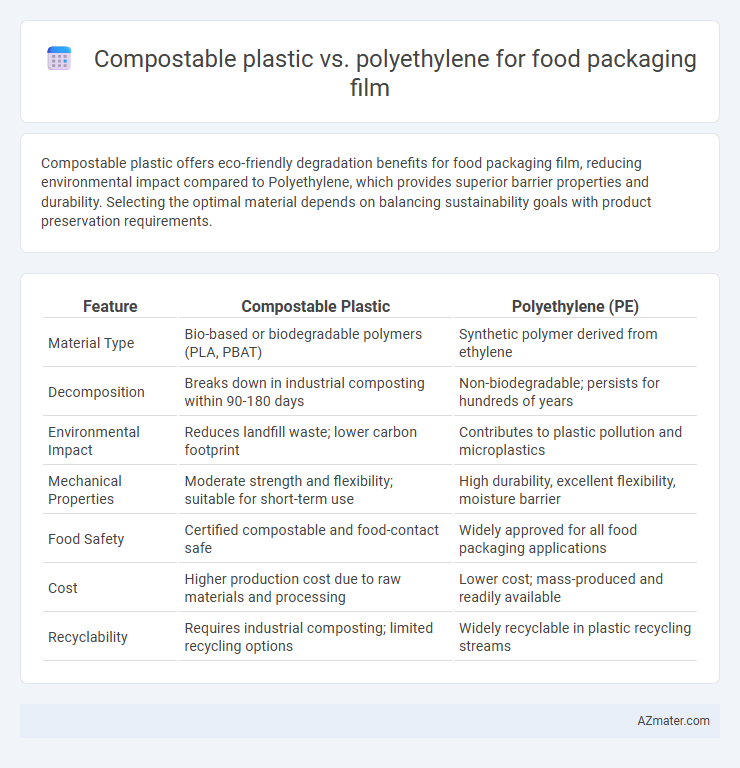Compostable plastic offers eco-friendly degradation benefits for food packaging film, reducing environmental impact compared to Polyethylene, which provides superior barrier properties and durability. Selecting the optimal material depends on balancing sustainability goals with product preservation requirements.
Table of Comparison
| Feature | Compostable Plastic | Polyethylene (PE) |
|---|---|---|
| Material Type | Bio-based or biodegradable polymers (PLA, PBAT) | Synthetic polymer derived from ethylene |
| Decomposition | Breaks down in industrial composting within 90-180 days | Non-biodegradable; persists for hundreds of years |
| Environmental Impact | Reduces landfill waste; lower carbon footprint | Contributes to plastic pollution and microplastics |
| Mechanical Properties | Moderate strength and flexibility; suitable for short-term use | High durability, excellent flexibility, moisture barrier |
| Food Safety | Certified compostable and food-contact safe | Widely approved for all food packaging applications |
| Cost | Higher production cost due to raw materials and processing | Lower cost; mass-produced and readily available |
| Recyclability | Requires industrial composting; limited recycling options | Widely recyclable in plastic recycling streams |
Introduction to Food Packaging Films
Food packaging films must provide barrier properties, flexibility, and durability to preserve product freshness and safety. Compostable plastics, derived from renewable resources like polylactic acid (PLA) or starch blends, offer eco-friendly alternatives that biodegrade under industrial composting conditions, reducing environmental impact. Polyethylene films, widely used for food packaging, deliver excellent moisture resistance, strength, and cost efficiency but pose challenges in disposal due to their persistence in landfills and limited recyclability.
Understanding Compostable Plastics
Compostable plastics, derived from renewable biomass sources like corn starch or sugarcane, break down into non-toxic components within industrial composting environments, offering an eco-friendly alternative to traditional polyethylene films. Unlike polyethylene, which is petroleum-based and persists in the environment for centuries, compostable plastics reduce landfill waste and lower carbon footprints by converting into humus and water vapor under controlled conditions. Understanding the specific ASTM D6400 or EN 13432 certification standards is crucial for determining the biodegradability and suitability of compostable plastics in food packaging applications.
What is Polyethylene in Food Packaging?
Polyethylene in food packaging is a versatile thermoplastic polymer widely used for its excellent moisture barrier, flexibility, and durability. Common forms such as low-density polyethylene (LDPE) and high-density polyethylene (HDPE) offer clarity and strength, making them ideal for wrapping and sealing food products to maintain freshness. Its cost-effectiveness and strong sealing properties contribute significantly to the global dominance of polyethylene in food packaging films.
Environmental Impact: Compostable vs Polyethylene
Compostable plastic for food packaging film significantly reduces environmental impact by breaking down into natural elements within months, minimizing landfill waste and microplastic pollution. Polyethylene, a widely used petroleum-based plastic, persists in the environment for hundreds of years, contributing to plastic accumulation and harmful ecological effects. Opting for compostable alternatives supports circular economy initiatives and lowers greenhouse gas emissions compared to conventional polyethylene films.
Biodegradability and End-of-Life Scenarios
Compostable plastics for food packaging films are designed to biodegrade under industrial composting conditions, breaking down into water, carbon dioxide, and biomass within months, whereas polyethylene relies on long-term environmental degradation that can take centuries. End-of-life scenarios for compostable plastics support organic recycling streams, reducing landfill waste and greenhouse gas emissions, while polyethylene primarily accumulates in landfills or requires energy-intensive mechanical or chemical recycling. The controlled biodegradability of compostable films aligns with circular economy principles, offering an eco-friendly alternative to the persistent pollution associated with conventional polyethylene packaging.
Food Safety and Chemical Migration
Compostable plastic food packaging films are designed to minimize chemical migration, reducing the risk of toxic substances leaching into food compared to conventional polyethylene films, which may release additives and plasticizers under certain conditions. Studies indicate that compostable materials, often derived from polylactic acid (PLA) or starch-based polymers, have lower migration rates of harmful compounds, enhancing food safety for short-term storage. Polyethylene films, while effective as a barrier, pose concerns over long-term chemical migration, especially when exposed to heat or fatty foods, necessitating stringent regulatory compliance to ensure consumer protection.
Material Performance and Shelf Life
Compostable plastic for food packaging film offers biodegradability and reduces environmental impact but typically has lower barrier properties and mechanical strength compared to polyethylene, resulting in shorter shelf life for perishable products. Polyethylene films provide superior moisture and oxygen barrier performance, enhancing product freshness and extending shelf life, which is critical for maintaining food quality during distribution. While compostable films are improving, polyethylene remains the industry standard for long-lasting, high-performance food packaging due to its durability and consistent protection against external factors.
Cost Comparison: Compostable Plastics vs Polyethylene
Compostable plastics typically cost 20-50% more than polyethylene for food packaging film due to raw material expenses and manufacturing processes. Polyethylene benefits from large-scale production and established supply chains, making it a more economical choice for high-volume packaging needs. Despite the higher initial cost, compostable plastics offer potential savings in waste management and environmental compliance that can offset expenses over time.
Regulatory Standards and Certifications
Compostable plastic food packaging films comply with established standards such as ASTM D6400 and EN 13432, ensuring biodegradability and compostability under industrial composting conditions, while polyethylene films must meet FDA and EU regulations for food safety and migration limits. Certifications like TUV Austria OK Compost and BPI verification validate compostable plastics' environmental claims, contrasting with polyethylene's compliance primarily centered on chemical stability and barrier properties. Regulatory frameworks increasingly favor biodegradable alternatives, influencing market adoption and labeling requirements in food packaging.
Future Trends in Sustainable Food Packaging
Compostable plastic for food packaging film is gaining momentum due to increasing consumer demand for eco-friendly alternatives and stricter regulatory policies targeting plastic waste reduction. Innovations in biodegradable polymer blends and enhanced compostability standards are driving market growth, while polyethylene remains widely used for its cost-effectiveness and barrier properties but faces challenges from environmental concerns. Future trends highlight a shift towards hybrid materials combining compostable polymers with bio-based additives, aiming to balance sustainability with performance in food preservation.

Infographic: Compostable plastic vs Polyethylene for Food packaging film
 azmater.com
azmater.com